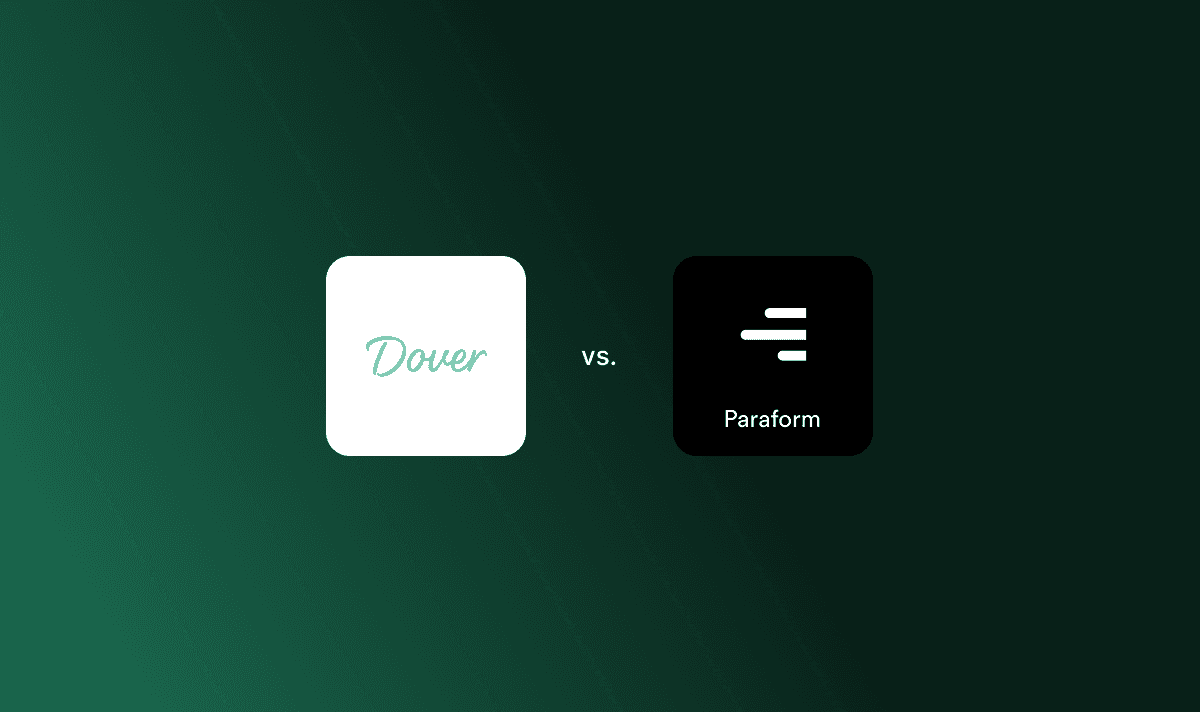Dover vs Paraform: Which recruiting model is right for your startup?

Max Kolysh
CEO
February 12, 2025
•
3 mins
Dover: Fractional Recruiting Marketplace
Dover is a marketplace for fractional recruiters. We hire recruiters with a ton of startup hiring experience, and they work with you on a flexible, part-time basis. Instead of paying per hire, you pay hourly to get a dedicated recruiter who integrates with your team.
Recruiters work closely with founders to run sourcing, outreach, interviews, and offer negotiations, and they often handle multiple roles at once. It’s most similar to a full-time recruiter. Because you’re paying for work done rather than a bounty per hire, our cost per hire is typically 3-5x lower than contingency recruiters.
Paraform: Contingency Recruiter Marketplace
Paraform operates on a contingency model, meaning companies only pay if they make a hire. This is also known as a "success fee". Instead of hiring a dedicated recruiter, you post a job and multiple independent recruiters compete to fill it. The typical fee is 15-30% of a hire’s first-year salary, meaning a $150K engineering hire could cost $30K or more in recruiting fees.
The way the engagement works is that Paraform will connect you with a lot (10+) contingency recruiters at once. The nice thing about contingency is that you’re paying the same amount regardless of if you have 1 contingency recruiter or many recruiters working on the job (since you only pay when you make a hire).
Dover is much less expensive
Cost per hire is one of the clearest and most important metrics in startup hiring.
Dover’s cost per hire: Typically $2K-$8K, depending on the role and hiring timeline.
Paraform’s cost per hire: Typically $15K-$50K+, since the fee is a percentage (15-30%) of the candidate’s salary.
The reason for this difference is simple. Paraform operates on a contingency model, where multiple recruiters compete for the same role but only one gets paid. This means the majority of recruiters do uncompensated work, forcing them to charge higher success fees to make up for lost time on roles they don’t win. The companies that do hire end up subsidizing the companies that don’t.
With Dover, recruiters are paid for the actual work they do, rather than just the outcome. This results in lower overall costs per hire, more predictable spending, and a better recruiter-client relationship. It also means companies aren’t relying on a model that inherently creates inefficiencies and wasted effort.
Some founders wonder: “But isn’t paying only on success better? Doesn’t this align incentives perfectly?” Not exactly. While contingency recruiting means you don’t pay unless you hire, it also means you’re on the hook for a massive fee when you do. That’s why many startups eventually bring recruiting in-house after a couple of agency hires—because the costs become unsustainable. Dover, on the other hand, offers a flexible, long-term solution that scales with your company’s needs. With contingency, the customer is always unhappy: either you’re sad because you didn’t make a hire, or you’re sad because you paid a fortune.
Check out Dover’s full history of cost-per-hire data: dover.com/recruiter#cost-per-hire.
Dover attracts better recruiters
I often ask founders: “If you wanted to build a feature, would you ask 10 different engineers to work on contingency?” There’s a reason most companies don’t do this.
The same applies to recruiting. Paraform’s contingency model commoditizes recruiters—they are one of many competing for the same role, and they only get paid if they win. This isn’t great for recruiters, which means the best ones don’t stick around on their platform. Many recruiters on Paraform are taking on many projects at once, trying to hedge their bets. And contingency model makes the recruiter/client relationship transactional rather than a partnership.
Dover’s fractional recruiters get consistent work, predictable pay, and the ability to build long-term relationships with clients. The best recruiters want these things. This means the recruiters in Dover’s network are among the most experienced in the industry.
Dover grows with you
If you’re hiring multiple roles or want to build a repeatable recruiting process, Dover scales better. You can add or reduce recruiter hours as needed rather than committing to paying a large lump sum per hire.
Paraform works best if you just need to fill one or two roles quickly and don’t care as much about process or employer brand. But if you’re looking to grow your company long term and plan on making multiple hires, Dover’s flexibility, cost efficiency, and long-term approach make it a far better option.
Dover preserves your employer brand
One major drawback of contingency recruiting is how it affects your candidate experience. With Paraform, you have multiple recruiters working independently, often reaching out to the same candidates multiple times. This can make your company look disorganized or desperate, which isn’t a great first impression for top-tier talent.
Dover’s model doesn’t have this problem. Because our recruiters act as an extension of your team, all outreach is coordinated and branded under your company name. Candidates go through a structured, high-touch hiring experience, leading to better engagement and higher acceptance rates.
If you’re deciding between Dover and Paraform, ask yourself what you value most:
If speed is your only priority and you want to be bombarded with as many candidates as possible regardless of quality, you don’t care too much about employer brand, and don’t mind paying huge fees—Paraform will work for you.
If you want a much lower cost per hire and a dedicated recruiting partner who will represent your company like an in-house recruiter, Dover is the better choice.
Both models have their place, but for founders who care about cost, quality, and long-term hiring success, Dover is the clear winner.
Table of contents

